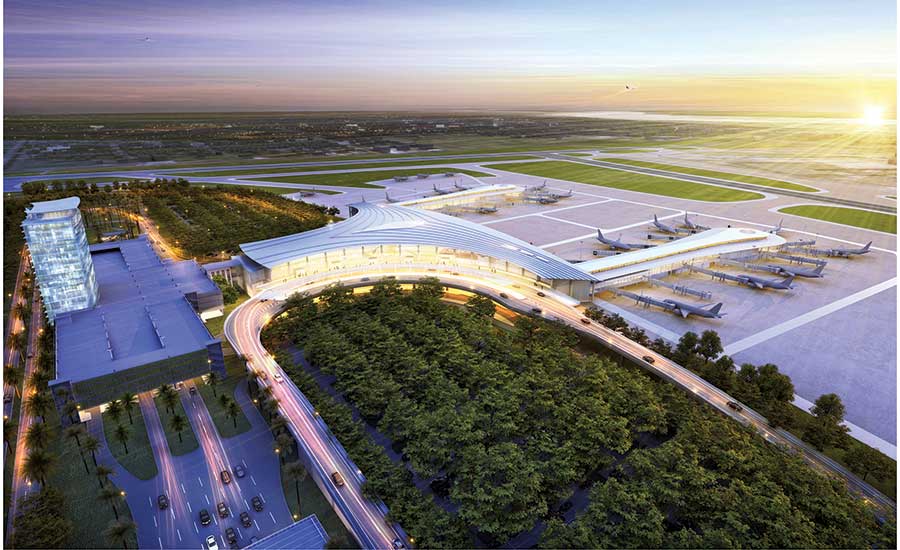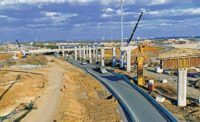Energy-related projects such as chemical plants and pipelines continued to hold many of the top spots in ENR Texas & Louisiana’s Top Starts ranking for 2016, but highway, bridge and airport work also was well represented in the top 10.
Axiall Corp.’s $3-billion ethane cracker plant in Lake Charles was the No. 1 ranked project. Other energy projects of note include Shell’s $717-million alpha olefins manufacturing plant expansion and Pin Oak Terminals’ nearly $550-million petroleum liquids storage terminal.
“We were standing on the cusp of about $180 billion worth of industrial work on the books, but I think some of that is not being done because of the depressed exploration,” says Ken Naquin, CEO of Louisiana AGC. “There’s some concern that with the lack of infrastructure some of that work is going to go out of state to Texas, which is spending a lot more in infrastructure to attract this heavy industrial work. Right now, our plants are looking at how can they get their goods and services and their people in and out of the plants when we don’t have an infrastructure system that will support it.”
|
ENR Texas & Louisiana 2016 Top Starts Ranking |
Naquin notes that if an infrastructure package is approved by the state Legislature, 2017 could be a boom year for Louisiana. “Highway infrastructure is way behind. It’s really suffering. If we can just get these highway guys some work to bid on, I think we’ll be all right,” he says.
Some areas are doing better than others in Louisiana, with commercial builders seeing plenty of work, mostly private, negotiated projects, Naquin says.
Meanwhile, New Orleans has close to a billion dollars in underground utility work as a result of the $1.2-billion Federal Emergency Management Agency settlement announced in 2016 stemming from Hurricane Katrina. Coastal work is also strong, with a large public works program statewide.
There is also the “Deepwater Horizon settlement money and offshore settlement money that’s going to be coming in shortly in 2018. We’re looking at a billion [dollars] a year in just coastal restoration and protection,” Naquin says.
Other Key Sectors
Highway work in Texas accounted for three of the region’s top 10 starts, including the $850-million State Highway 288 project, the $802-million U.S. 181 Harbor Bridge replacement and the $743-million U.S. 183 South project.
Major mixed-used developments included two Dallas projects, the $350-million Union Dallas and $200-million Park District. According to Eric Krueger, executive vice president of the Texas division at Balfour Beatty, the general contractor on the Park District project, most industry forecasts indicate a robust marketplace with moderate growth in store for the industry in 2017.
“Balfour Beatty anticipates a shift from private to the public sector with an increase in the municipal, transportation, health care and K-12 verticals. This need is a result of population growth that will continue in Texas,” Krueger says. “After the election, the prevailing sentiment was that the industry would see pro-growth programs propelled by the spending anticipated from President Donald Trump’s infrastructure plans. However, this is tempered by the availability of qualified, skilled craft workers which will remain a challenge during the next 12 months.”
With shortages continuing in both construction materials and labor, Krueger sees an increased trend toward lean construction methods such as offsite prefabrication and preassembly in order to increase productivity on jobsites, reduce the number of onsite workers and improve quality, safety and speed of delivery.
“The great thing about working in Texas in construction is that there’s a lot of it. The challenging thing is there’s a lot of it,” says Ray Sedey, Texas region president with McCarthy Building Cos., which is building two hospital projects on the Top Starts list—the $275-million CHRISTUS Spohn Shoreline Campus in Corpus Christi, Texas, and the $127-million Mercy Hospital Bed Tower in Rogers, Ark. “Everybody is seeing that there’s a craft labor shortage. But you’re starting to see the same thing on the salaried folks coming out of college, with graduates coming out of school with offers from multiple contractors.”
Getting people into the industry will remain a challenge, especially with the projects planned in the region, such as ExxonMobil’s recently announced $20-billion investment along the Gulf Coast, Sedey notes. “As the price of oil rebounds, you’re going to be looking at more work back in the oil fields in Texas, and with those two things working alongside a very robust construction market, I think you’re going to see a drain on getting both the management and the craft labor for our projects,” he says.
The No. 2 ranked project was Continental’s $1.4-billion tire manufacturing plant in Clinton, Miss., which includes a 750,000-sq-ft manufacturing facility and 25,000-sq-ft training facility, says Curnis Upkins III, director of business development at Hinds County Economic Development Authority. The plant will eventually employ 2,500 people, he says.
Upkins says that Mississippi has many large projects underway, especially in the Jackson area. After being in the planning stages for decades, the Byram-Clinton Corridor in Hinds County is making progress toward construction, he adds, with contractor bids reviewed for phased construction of the corridor in late March.
Although no Oklahoma projects made this year’s list, “the Oklahoma Turnpike Authority issued a $900-million improvement program in early 2016—so that design work is occurring right now,” says Wayne Feuerborn, vice president and Oklahoma City office leader at HNTB. Construction could begin later this year, he says. The lack of larger projects in Oklahoma is something that Feuerborn attributes to the fact that the state is “generally pay-as-you-go, so they want to be able to have funding available when they proceed on a project,” he says.






Post a comment to this article
Report Abusive Comment